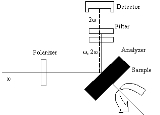
Surface second harmonic generation
Encyclopedia
Surface second harmonic generation is a method for probing interfaces in atomic and molecular systems. In second harmonic generation
(SHG), the light frequency is doubled, essentially converting two photon
s of the original beam of energy E into a single photon of energy 2E as it interacts with noncentrosymmetric media. Surface second harmonic generation is a special case of SHG where the second beam is generated because of a break of symmetry caused by an interface. Since symmetry is only disrupted in the first (occasionally second and third) atomic or molecular layer of a system, properties of the second harmonic signal give us information about the first atomic or molecular layers only. Surface SHG is possible even for materials which do not exhibit SHG in the bulk.
in 1962, one year after Franken et al. first discovered second harmonic generation in bulk crystal
s. Prior to Terhune’s discovery, it was believed that crystals could only exhibit second harmonic generation if the crystal was noncentrosymmetric. Terhune observed that calcite
, a centrosymetric crystal which is only capable of SHG in the bulk in the presence of an applied electric field which would break the symmetry of the electronic structure, surprisingly also produced a second harmonic signal in the absence of an external electric field
. During the 1960s, SHG was observed for many other centrosymmetric media including metal
s, semiconductor
s, oxide
s, and liquid
s. In 1968, Bloembergen
et al. showed that the second harmonic signal was generated from the surface.
Interest in this field waned during the 1970s and only a handful of research groups investigated surface SHG, most notably Y. R. Shen’s group at University of California at Berkeley who has written two reviews on surface SHG. During the 70s and 80s, most of the research in this field focused on understanding the electron
response, particularly in metals. In 1981, Chen et al. showed that SHG could be used to detect individual monolayer
s, and since then, much research has gone into using and understanding SHG as surface probe of molecular adsorption and orientation.
χ(2). While the χ(2) tensor contains 27 elements, many of these elements are reduced by symmetry arguments. The exact nature of these arguments depends on the application. When determining molecular orientation, it is assumed that χ(2) is rotationally invariant around the z-axis (normal to the surface). The number of tensor elements from 27 to the following 7 independent quantities: χZZZ, χZXX = χZYY, χXZX = χYZY, χXXZ = χYYZ, χXYZ = -χYXZ, χXZY = -χYZX, χZXY = -χZYX.
Second Harmonic Generation further restricts the independent terms by requiring the tensor is symmetric in the last two indices reducing the number of independent tensor terms to 4: χZZZ, χZXX (equivalently χZYY), χXXZ (equivalently χXZX , χYZY, χYYZ), χXYZ (equivalently χXZY, -χYXZ, -χYZX). In order for χZXY = -χZYX to hold under this final condition, both terms must be 0. The four independent terms are material dependent properties and can vary as the external conditions change. These four terms give rise to the second harmonic signal, and allow for calculation of material properties such as electronic structure, atomic organization, and molecular orientation.
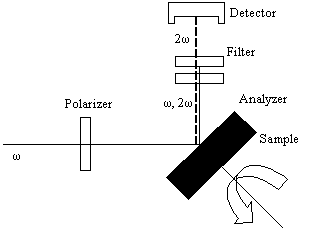
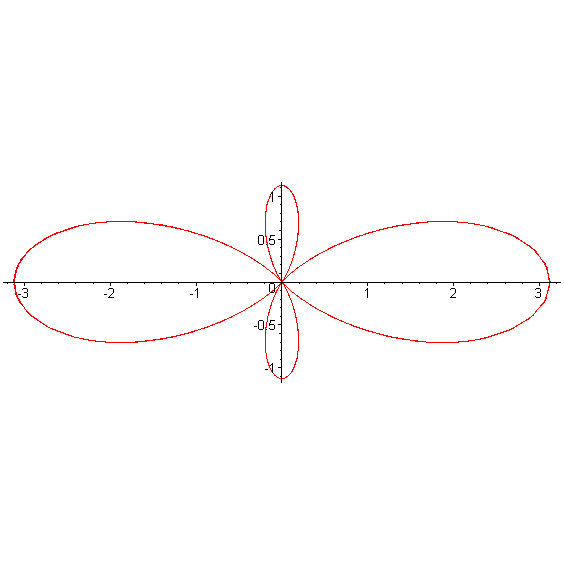 It may seem paradoxical at first that surface SHG which relies on a break in symmetry is possible in crystals which have an inherent symmetric structure. At a crystalline interface half of the atomic forces experienced in the bulk crystal are not present which causes changes in the atomic and electronic structures. There are two major changes that occur at the interface: 1) the interplaner distances of the top layers change and 2) the atoms redistribute themselves to a completely new packing structure. While symmetry is maintained in the surface planes, the break in symmetry out-of-plane modifies the second-order susceptibility tensor χ(2), giving rise to optical second harmonic generation.
It may seem paradoxical at first that surface SHG which relies on a break in symmetry is possible in crystals which have an inherent symmetric structure. At a crystalline interface half of the atomic forces experienced in the bulk crystal are not present which causes changes in the atomic and electronic structures. There are two major changes that occur at the interface: 1) the interplaner distances of the top layers change and 2) the atoms redistribute themselves to a completely new packing structure. While symmetry is maintained in the surface planes, the break in symmetry out-of-plane modifies the second-order susceptibility tensor χ(2), giving rise to optical second harmonic generation.
Typical measurements of SHG from crystalline surfaces structures are performed by rotating the sample in an incident beam (Figure 1). The second harmonic signal will vary with the azimuth angle of the sample due to the symmetry of the atomic and electronic structure (Figure 2). As a result, surface SHG theory is highly dependent on geometry of the superstructure. Since electron interactions are responsible for the SHG response, the jellium model is usually numerically solved using Density Functional Theory to predict the SHG response of a given surface. SHG sensitivity to surface structure approach was effectively demonstrated by Heinz, Loy, and Thompson, working for IBM
in 1985. They showed that the SHG signal from a freshly cleaved Si
(111) surface would alter its behavior as the temperature was raised and the superstructure changed from a 2x1 structure to the 7x7 structure. Noting the change in signal, they were able to verify the existence of one mirror plane in the 2x1 construction and 3 mirror planes in the 7x7 construction thereby providing new information to the bonding structure of the surface atoms. Since then, surface SHG has been used to probe other many other metallic surfaces such as reconstructed gold
(110), Pd
(111), and Al
(100).
Perhaps one of the most powerful uses of surface SHG is the probing of surface structure of buried interfaces. Traditional surface tools such as Atomic Force Microscopy and Scanning Tunneling Microscopy as well as many forms of electron diffraction
must be conducted under vacuum
, and are not sensitive to interfaces deeper in the probed medium. SHG measurements allow the incident laser beam to pass without interaction through higher level materials to the target interface where the second harmonic signal is generated. In cases where the transmitting materials do interact with the beam, these contributions to the second harmonic signal can be resolved in other experiments and subtracted out. The resulting measured second harmonic signal contains the second harmonic component from the buried interface alone. This type of measurement is useful for determining the surface structure of the interface. As an example, Cheikh-Rouhou et al. demonstrated this process to resolve interface structures of 5 layer systems.
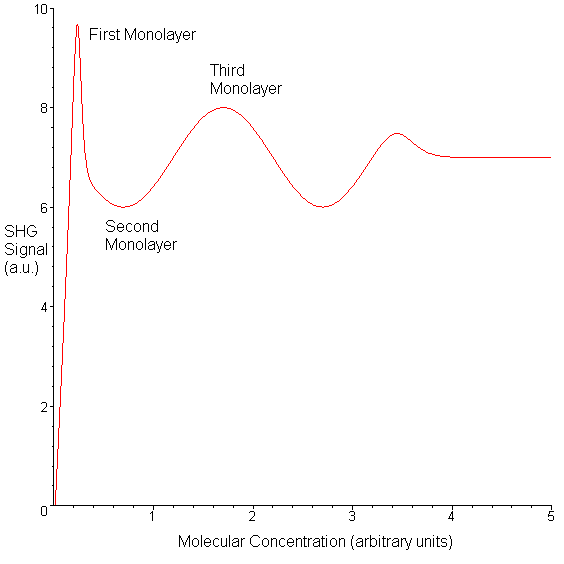 Surface SHG is very useful for monitoring the growth of monolayers on a surface. As particles adsorb, the SHG signal is altered. Two common applications in surface science are the adsorption of small gas molecules onto a surface and the adsorption of dissolved dye molecules in a liquid to a surface. Bourguignon et al. showed that as carbon monoxide
Surface SHG is very useful for monitoring the growth of monolayers on a surface. As particles adsorb, the SHG signal is altered. Two common applications in surface science are the adsorption of small gas molecules onto a surface and the adsorption of dissolved dye molecules in a liquid to a surface. Bourguignon et al. showed that as carbon monoxide
is adsorbed onto a Pd(111) surface, the SHG signal decreased exponentially as predicted by the Langmuir isotherm. As CO coverage approached 1 monolayer, the SHG intensity leveled off. Larger molecules like dyes often can form multilayers on a surface, and this can be measured in situ using SHG. As the first monolayer forms, the intensity can often be seen to increase to a maximum until a uniform distribution of particles is obtained (Figure 3). As additional particles adsorb and the second monolayer begins to form, the SHG signal decreases until it reaches a minimum at the completion of the second monolayer. This alternating behavior can typically be seen for the growth of monolayers. As additional layers form, the SHG response of the substrate is screened by the adsorbate and eventually, the SHG signal levels off.
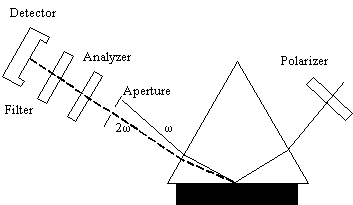 As molecular layers adsorb to surfaces it is often useful to know the molecular orientation of the adsorbed molecules. Molecular orientation can be probed by observing the polarization of the second harmonic signal, generated from a polarized beam. Figure 4 shows a typical experimental geometry for molecular orientation experiments. The beam is incident on the sample in a total internal reflection geometry which improves the second harmonic signal because as the wave propagates along the interface, additional second harmonic photons are generated, By rotating either the polarizer or the analyzer, the s- and p-polarized signals are measured which allow for the calculation of the second-order susceptibility tensor χ(2). Simpson’s research group has studied this phenomenon in depth. The molecular orientation can differ from the laboratory axis in three directions, corresponding to three angles. Typically, SHG measurements of this type are only able to extract a single parameter, namely the molecular orientation with respect to the surface normal.
As molecular layers adsorb to surfaces it is often useful to know the molecular orientation of the adsorbed molecules. Molecular orientation can be probed by observing the polarization of the second harmonic signal, generated from a polarized beam. Figure 4 shows a typical experimental geometry for molecular orientation experiments. The beam is incident on the sample in a total internal reflection geometry which improves the second harmonic signal because as the wave propagates along the interface, additional second harmonic photons are generated, By rotating either the polarizer or the analyzer, the s- and p-polarized signals are measured which allow for the calculation of the second-order susceptibility tensor χ(2). Simpson’s research group has studied this phenomenon in depth. The molecular orientation can differ from the laboratory axis in three directions, corresponding to three angles. Typically, SHG measurements of this type are only able to extract a single parameter, namely the molecular orientation with respect to the surface normal.
where γ is the polarization angle with γ = 0 corresponding to p-polarized light. The si terms depend on the experimental geometry are functions of the total internal reflection angles of the incident and second harmonic beams and the linear and nonlinear Fresnel factors
respectively which relate the electric field components at the interface to incident and detected fields.
The second-order susceptibility tensor, χ(2), is the parameter which can be measured in second order experiments, but it does not explicitly provide insight to the molecular orientation of surface molecules. To determine molecular orientation, the second-order hyperpolarizability
tensor β, must be calculated. For adsorbed molecules in a uniaxial distribution, the only independent hyperpolarizability tensor terms are βz’z’z’, βz’x’x’, and βx’x’z’ where ’ terms denote the molecular coordinate system as opposed to the laboratory coordinate system. β can be related to χ(2) through orientational averages. As an example, in an isotropic distribution on the surface, χ(2) elements are given by.
where Ns is the surface number density of the adsorbed molecules, θ and Ψ are orientational angles relating the molecular coordinate system to the laboratory coordinate system, and represents the average value of x. In many cases, only or two of the molecular hyperpolarizability tensor are dominant. In these cases, the relationships between χ and β can be simplified. Bernhard Dick presents several of these simplifications.
the second harmonic signal is magnified and surface features are imaged with a resolution on the order of a wavelength. Surface SHG can also be used to monitor chemical reactions at a surface with picosecond resolution.
Second harmonic generation
An optical frequency multiplier is a nonlinear optical device, in which photons interacting with a nonlinear material are effectively "combined" to form new photons with greater energy, and thus higher frequency...
(SHG), the light frequency is doubled, essentially converting two photon
Photon
In physics, a photon is an elementary particle, the quantum of the electromagnetic interaction and the basic unit of light and all other forms of electromagnetic radiation. It is also the force carrier for the electromagnetic force...
s of the original beam of energy E into a single photon of energy 2E as it interacts with noncentrosymmetric media. Surface second harmonic generation is a special case of SHG where the second beam is generated because of a break of symmetry caused by an interface. Since symmetry is only disrupted in the first (occasionally second and third) atomic or molecular layer of a system, properties of the second harmonic signal give us information about the first atomic or molecular layers only. Surface SHG is possible even for materials which do not exhibit SHG in the bulk.
History
Second harmonic generation from a surface was first observed by R. W. Terhune, P. D. Maker, and C. M. Savage working for the Ford Motor CompanyFord Motor Company
Ford Motor Company is an American multinational automaker based in Dearborn, Michigan, a suburb of Detroit. The automaker was founded by Henry Ford and incorporated on June 16, 1903. In addition to the Ford and Lincoln brands, Ford also owns a small stake in Mazda in Japan and Aston Martin in the UK...
in 1962, one year after Franken et al. first discovered second harmonic generation in bulk crystal
Crystal
A crystal or crystalline solid is a solid material whose constituent atoms, molecules, or ions are arranged in an orderly repeating pattern extending in all three spatial dimensions. The scientific study of crystals and crystal formation is known as crystallography...
s. Prior to Terhune’s discovery, it was believed that crystals could only exhibit second harmonic generation if the crystal was noncentrosymmetric. Terhune observed that calcite
Calcite
Calcite is a carbonate mineral and the most stable polymorph of calcium carbonate . The other polymorphs are the minerals aragonite and vaterite. Aragonite will change to calcite at 380-470°C, and vaterite is even less stable.-Properties:...
, a centrosymetric crystal which is only capable of SHG in the bulk in the presence of an applied electric field which would break the symmetry of the electronic structure, surprisingly also produced a second harmonic signal in the absence of an external electric field
Electric field
In physics, an electric field surrounds electrically charged particles and time-varying magnetic fields. The electric field depicts the force exerted on other electrically charged objects by the electrically charged particle the field is surrounding...
. During the 1960s, SHG was observed for many other centrosymmetric media including metal
Metal
A metal , is an element, compound, or alloy that is a good conductor of both electricity and heat. Metals are usually malleable and shiny, that is they reflect most of incident light...
s, semiconductor
Semiconductor
A semiconductor is a material with electrical conductivity due to electron flow intermediate in magnitude between that of a conductor and an insulator. This means a conductivity roughly in the range of 103 to 10−8 siemens per centimeter...
s, oxide
Oxide
An oxide is a chemical compound that contains at least one oxygen atom in its chemical formula. Metal oxides typically contain an anion of oxygen in the oxidation state of −2....
s, and liquid
Liquid
Liquid is one of the three classical states of matter . Like a gas, a liquid is able to flow and take the shape of a container. Some liquids resist compression, while others can be compressed. Unlike a gas, a liquid does not disperse to fill every space of a container, and maintains a fairly...
s. In 1968, Bloembergen
Nicolaas Bloembergen
Nicolaas Bloembergen is a Dutch-American physicist and Nobel laureate.He received his Ph.D. degree from University of Leiden in 1948; while pursuing his PhD at Harvard, Bloembergen also worked part-time as a graduate research assistant for Edward Mills Purcell at the MIT Radiation Laboratory...
et al. showed that the second harmonic signal was generated from the surface.
Interest in this field waned during the 1970s and only a handful of research groups investigated surface SHG, most notably Y. R. Shen’s group at University of California at Berkeley who has written two reviews on surface SHG. During the 70s and 80s, most of the research in this field focused on understanding the electron
Electron
The electron is a subatomic particle with a negative elementary electric charge. It has no known components or substructure; in other words, it is generally thought to be an elementary particle. An electron has a mass that is approximately 1/1836 that of the proton...
response, particularly in metals. In 1981, Chen et al. showed that SHG could be used to detect individual monolayer
Monolayer
- Chemistry :A Langmuir monolayer or insoluble monolayer is a one-molecule thick layer of an insoluble organic material spread onto an aqueous subphase. Traditional compounds used to prepare Langmuir monolayers are amphiphilic materials that possess a hydrophilic headgroup and a hydrophobic tail...
s, and since then, much research has gone into using and understanding SHG as surface probe of molecular adsorption and orientation.
Excitation of second harmonic signal
Just as bulk second harmonic generation, surface SHG arises out of the second-order susceptibility tensorTensor
Tensors are geometric objects that describe linear relations between vectors, scalars, and other tensors. Elementary examples include the dot product, the cross product, and linear maps. Vectors and scalars themselves are also tensors. A tensor can be represented as a multi-dimensional array of...
χ(2). While the χ(2) tensor contains 27 elements, many of these elements are reduced by symmetry arguments. The exact nature of these arguments depends on the application. When determining molecular orientation, it is assumed that χ(2) is rotationally invariant around the z-axis (normal to the surface). The number of tensor elements from 27 to the following 7 independent quantities: χZZZ, χZXX = χZYY, χXZX = χYZY, χXXZ = χYYZ, χXYZ = -χYXZ, χXZY = -χYZX, χZXY = -χZYX.
Second Harmonic Generation further restricts the independent terms by requiring the tensor is symmetric in the last two indices reducing the number of independent tensor terms to 4: χZZZ, χZXX (equivalently χZYY), χXXZ (equivalently χXZX , χYZY, χYYZ), χXYZ (equivalently χXZY, -χYXZ, -χYZX). In order for χZXY = -χZYX to hold under this final condition, both terms must be 0. The four independent terms are material dependent properties and can vary as the external conditions change. These four terms give rise to the second harmonic signal, and allow for calculation of material properties such as electronic structure, atomic organization, and molecular orientation.
Interface structure


Typical measurements of SHG from crystalline surfaces structures are performed by rotating the sample in an incident beam (Figure 1). The second harmonic signal will vary with the azimuth angle of the sample due to the symmetry of the atomic and electronic structure (Figure 2). As a result, surface SHG theory is highly dependent on geometry of the superstructure. Since electron interactions are responsible for the SHG response, the jellium model is usually numerically solved using Density Functional Theory to predict the SHG response of a given surface. SHG sensitivity to surface structure approach was effectively demonstrated by Heinz, Loy, and Thompson, working for IBM
IBM
International Business Machines Corporation or IBM is an American multinational technology and consulting corporation headquartered in Armonk, New York, United States. IBM manufactures and sells computer hardware and software, and it offers infrastructure, hosting and consulting services in areas...
in 1985. They showed that the SHG signal from a freshly cleaved Si
Silicon
Silicon is a chemical element with the symbol Si and atomic number 14. A tetravalent metalloid, it is less reactive than its chemical analog carbon, the nonmetal directly above it in the periodic table, but more reactive than germanium, the metalloid directly below it in the table...
(111) surface would alter its behavior as the temperature was raised and the superstructure changed from a 2x1 structure to the 7x7 structure. Noting the change in signal, they were able to verify the existence of one mirror plane in the 2x1 construction and 3 mirror planes in the 7x7 construction thereby providing new information to the bonding structure of the surface atoms. Since then, surface SHG has been used to probe other many other metallic surfaces such as reconstructed gold
Gold
Gold is a chemical element with the symbol Au and an atomic number of 79. Gold is a dense, soft, shiny, malleable and ductile metal. Pure gold has a bright yellow color and luster traditionally considered attractive, which it maintains without oxidizing in air or water. Chemically, gold is a...
(110), Pd
Palladium
Palladium is a chemical element with the chemical symbol Pd and an atomic number of 46. It is a rare and lustrous silvery-white metal discovered in 1803 by William Hyde Wollaston. He named it after the asteroid Pallas, which was itself named after the epithet of the Greek goddess Athena, acquired...
(111), and Al
Aluminium
Aluminium or aluminum is a silvery white member of the boron group of chemical elements. It has the symbol Al, and its atomic number is 13. It is not soluble in water under normal circumstances....
(100).
Perhaps one of the most powerful uses of surface SHG is the probing of surface structure of buried interfaces. Traditional surface tools such as Atomic Force Microscopy and Scanning Tunneling Microscopy as well as many forms of electron diffraction
Electron diffraction
Electron diffraction refers to the wave nature of electrons. However, from a technical or practical point of view, it may be regarded as a technique used to study matter by firing electrons at a sample and observing the resulting interference pattern...
must be conducted under vacuum
Vacuum
In everyday usage, vacuum is a volume of space that is essentially empty of matter, such that its gaseous pressure is much less than atmospheric pressure. The word comes from the Latin term for "empty". A perfect vacuum would be one with no particles in it at all, which is impossible to achieve in...
, and are not sensitive to interfaces deeper in the probed medium. SHG measurements allow the incident laser beam to pass without interaction through higher level materials to the target interface where the second harmonic signal is generated. In cases where the transmitting materials do interact with the beam, these contributions to the second harmonic signal can be resolved in other experiments and subtracted out. The resulting measured second harmonic signal contains the second harmonic component from the buried interface alone. This type of measurement is useful for determining the surface structure of the interface. As an example, Cheikh-Rouhou et al. demonstrated this process to resolve interface structures of 5 layer systems.
Adsorption measurements

Carbon monoxide
Carbon monoxide , also called carbonous oxide, is a colorless, odorless, and tasteless gas that is slightly lighter than air. It is highly toxic to humans and animals in higher quantities, although it is also produced in normal animal metabolism in low quantities, and is thought to have some normal...
is adsorbed onto a Pd(111) surface, the SHG signal decreased exponentially as predicted by the Langmuir isotherm. As CO coverage approached 1 monolayer, the SHG intensity leveled off. Larger molecules like dyes often can form multilayers on a surface, and this can be measured in situ using SHG. As the first monolayer forms, the intensity can often be seen to increase to a maximum until a uniform distribution of particles is obtained (Figure 3). As additional particles adsorb and the second monolayer begins to form, the SHG signal decreases until it reaches a minimum at the completion of the second monolayer. This alternating behavior can typically be seen for the growth of monolayers. As additional layers form, the SHG response of the substrate is screened by the adsorbate and eventually, the SHG signal levels off.
Molecular orientation

Calculation of molecular orientation
When dealing with adsorbed molecules on a surface, it is typical to find a uniaxial distribution of the molecules, resulting in x- and y- coordinate terms to be interchangeable. When analyzing the second-order susceptibility tensor χ(2), the quantities χXYZ = -χYXZ must be 0 and only three independent tensor terms remain: χzzz, χzxx, and χxxz. The intensities of the s and p polarizations in the second harmonic are given by following relationships:where γ is the polarization angle with γ = 0 corresponding to p-polarized light. The si terms depend on the experimental geometry are functions of the total internal reflection angles of the incident and second harmonic beams and the linear and nonlinear Fresnel factors
Fresnel equations
The Fresnel equations , deduced by Augustin-Jean Fresnel , describe the behaviour of light when moving between media of differing refractive indices...
respectively which relate the electric field components at the interface to incident and detected fields.
The second-order susceptibility tensor, χ(2), is the parameter which can be measured in second order experiments, but it does not explicitly provide insight to the molecular orientation of surface molecules. To determine molecular orientation, the second-order hyperpolarizability
Hyperpolarizability
The hyperpolarizability, a nonlinear-optical property of a molecule, is the second-order electric susceptibility per unit volume. See nonlinear optics....
tensor β, must be calculated. For adsorbed molecules in a uniaxial distribution, the only independent hyperpolarizability tensor terms are βz’z’z’, βz’x’x’, and βx’x’z’ where ’ terms denote the molecular coordinate system as opposed to the laboratory coordinate system. β can be related to χ(2) through orientational averages. As an example, in an isotropic distribution on the surface, χ(2) elements are given by.
where Ns is the surface number density of the adsorbed molecules, θ and Ψ are orientational angles relating the molecular coordinate system to the laboratory coordinate system, and
Additional applications
In addition to these applications, Surface SHG is used to probe other effects. In surface spectroscopy, where either the fundamental or second harmonic are resonant with electronic transitions in the surface atoms, details can be determined about the electronic structure and band gaps. In monolayer microscopySecond harmonic imaging microscopy
Second-harmonic imaging microscopy is based on a nonlinear optical effect known as second-harmonic generation . SHIM has been established as a viable microscope imaging contrast mechanism for visualization of cell and tissue structure and function...
the second harmonic signal is magnified and surface features are imaged with a resolution on the order of a wavelength. Surface SHG can also be used to monitor chemical reactions at a surface with picosecond resolution.






